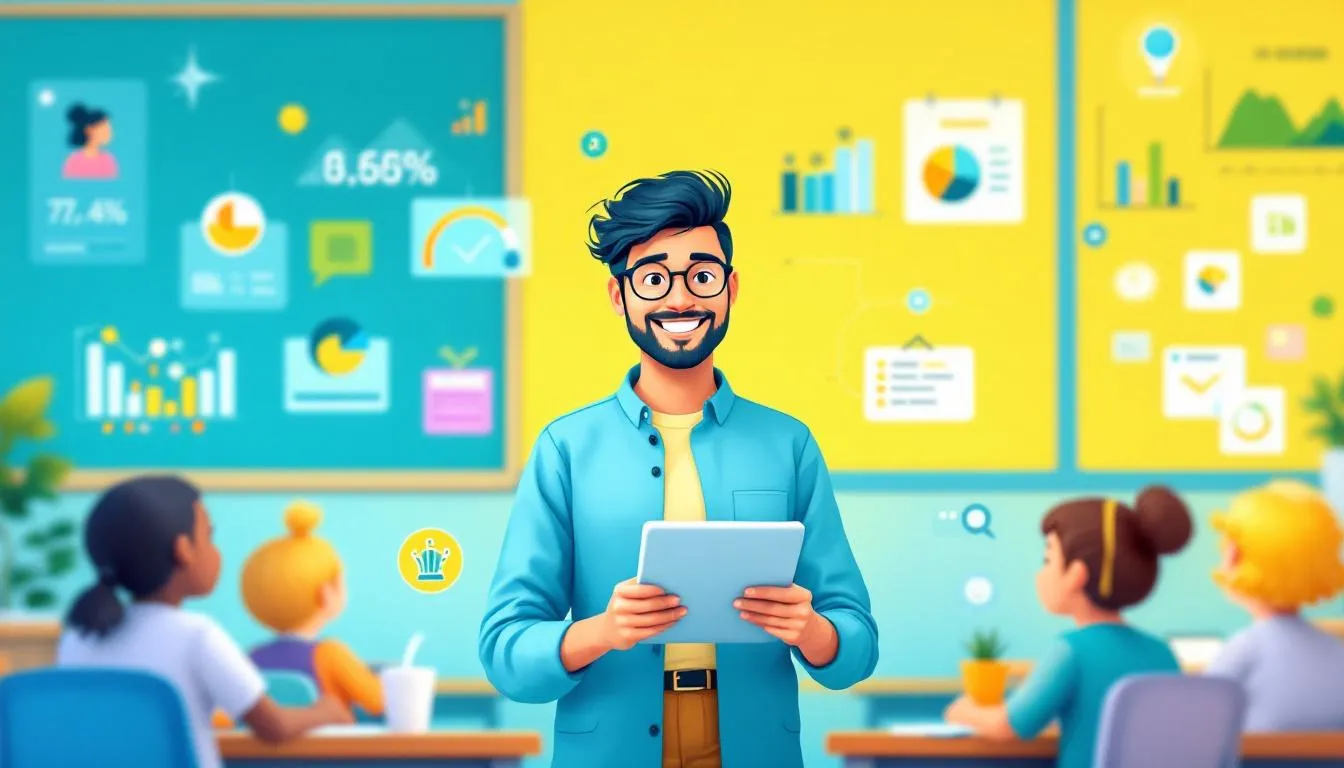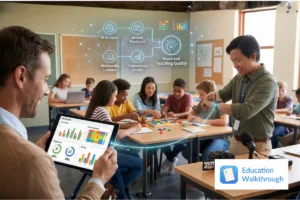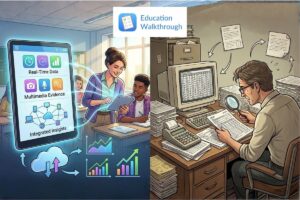Observation apps improve teaching quality by providing real-time data and actionable feedback that allows educators to adjust instruction immediately.
Instead of waiting for delayed reports, teachers use these digital tools to spot engagement trends, refine pacing, and implement personalized learning strategies instantly.
This guide explores the benefits of real-time data, AI integration, and multimedia evidence in modern classroom observation.
Principales conclusiones
- Observation apps enhance teaching quality by providing real-time feedback and data-driven insights, allowing teachers to adjust methods and foster continuous professional development.
- Integrating AI and multimedia evidence refines objective data collection, promoting transparent evaluations and personalized student learning.
- Collaboration through observation apps reduces teacher anxiety and boosts confidence, as educators receive constructive feedback and support in a more dynamic and responsive environment.
How Do Observation Apps Transform Teaching Quality?

Observation apps are reshaping classroom practice by giving teachers real-time insights they can use immediately. Instead of waiting weeks for feedback, educators see what is working during a lesson and adjust instruction on the spot to boost student engagement, improve academic performance, and support personalized learning.
With classroom observations stored digitally, teachers gain an objective perspective rather than relying on memory or handwritten notes. Reviewing recorded lessons helps educators analyze their teaching techniques in the actual physical environment, identify what supported learning, and refine learning materials based on student needs. This insight leads to faster and more targeted instructional improvements.
By integrating technology into observation practices, schools make feedback more consistent, collaborative, and actionable. As a result, classrooms benefit from stronger learning outcomes, reduced practical challenges for teachers, and a culture of continuous growth where both educators and students feel supported.
How Does Instant Feedback Move Learning Forward?
Instant feedback moves learning forward by providing teachers with actionable insights while the lesson is still fresh, eliminating the lag between observation and correction.
Research confirms that this immediacy drives results: a 2019 study in Frontiers in Psychology shows that immediate feedback improves teaching within just 1–2 instructional cycles, while real-time tracking boosts formative assessment accuracy by 10–15%.
This transforms observation from a retroactive critique into a proactive support tool, allowing educators to adjust pacing and grouping before confusion builds.
Real-time feedback helps teachers grow without slowing down their day. It turns observation into support, not pressure.
Real-time data empowers teachers to execute immediate instructional micro-adjustments:
- Adjust Pacing: Modifying the speed of instruction or questioning strategies before student confusion escalates.
- Target Interventions: Identifying specific students who need help and intervening during the lesson.
- Re-engage Learners: Spotting and reconnecting with disengaged students to lift classroom energy.
- Iterate Quickly: Implementing small, incremental changes that compound into significant learning gains.
This creates a classroom culture where improvement happens continuously, not only after formal evaluations. Teachers don’t wait months to try new strategies; they can make meaningful shifts the same week, sometimes the same day.
How Do Apps Enhance Teacher Reflection?
Observation apps don’t just capture what happens in class; they help teachers see their own teaching more clearly. With video and multimedia evidence, teachers can revisit key moments, notice patterns in student engagement, and reflect without relying on memory from a busy lesson.
Research quietly supports this shift toward video reflection. When teachers watch short clips of their own lessons, they tend to reflect more often and more honestly about their practice. Other studies show that when video reflection is paired with peer coaching, teachers experience clear improvements in classroom management and lesson delivery. In simple terms, reviewing your own teaching works is helpful because you notice things you can’t catch in real time.
Observation apps make reflective practice easier by allowing teachers to:
- Replay only the moments that matter instead of complete lessons
- See whether changes in pacing, questioning, or grouping improved student engagement
- Share clips for feedback only when they choose (not mandatory)
- watch their own progress develop over time
This turns reflection into something supportive, safe, and helpful, rather than something tied solely to high-stakes evaluations. Teachers gain confidence as they see their growth and how minor adjustments can change student participation and learning.
How Does Objective Data Improve Instruction?
Objective data collection improves instruction by converting subjective impressions into quantifiable metrics that teachers can analyze without bias. By using machine learning algorithms to track specific data points—such as student response times or participation rates—apps generate clear visualizations that highlight trends invisible to the naked eye.
This shift from memory-based notes to hard data helps teachers separate their perception of a lesson from the reality of student performance, leading to more accurate instructional adjustments.
These tools also make it easier to track progress over time. Teachers can monitor student participation, lesson flow, and areas where students need extra help. The feedback becomes specific, practical, and simple to apply.
Some observation apps use machine learning algorithms to highlight useful trends, like moments when pacing was strong, when students were most engaged, or when instruction supported deeper understanding. This helps teachers focus on strategies that lead to strong results.
In short, objective data helps teachers:
- understand what actually happened in the lesson
- receive immediate feedback that supports professional development
- make informed instructional decisions based on student data
In our testing of the platform, Education Walkthrough successfully converted raw observation notes into visual dashboards, allowing school leaders to identify trends in minutes rather than hours.
Try Education Walkthrough for Free
Why Is Multimedia Evidence Critical for Feedback?
Multimedia evidence is critical because it creates a shared, objective reference point that removes ambiguity from feedback conversations.
According to a 2022 study, teacher satisfaction increases by 18% when feedback includes multimedia evidence, and video-assisted reflection leads to a 22% higher adoption of targeted strategies compared to text alone.
When teachers can see and hear the exact moment being discussed, they no longer have to guess the observer’s intent, making professional growth feel supportive rather than corrective.
In daily practice, multimedia helps teachers:
- Understand precisely what worked and why
- Revisit key moments of student participation and learning
- Reflect more meaningfully at their own pace
Platforms like Education Walkthrough streamline this process by allowing observers to attach clips, screenshots, and time-stamped notes directly to walkthrough summaries. Teachers no longer guess what feedback refers to; they can see it, study it, and apply it immediately, supporting structured observation cycles that build confidence and consistency over time.
When feedback is grounded in objective classroom evidence, professional growth feels supportive rather than corrective. Teachers gain clarity, students benefit from faster improvements, and the entire learning environment becomes more responsive and collaborative.
How Do Customizable Templates Standardize Evaluations?
Customizable templates make classroom evaluations more consistent and fair without forcing every teacher into a one-size-fits-all model. Schools can maintain a standard structure while adjusting the look-fors to align with grade levels, subjects, and school-wide priorities. This makes feedback clearer, more relevant, and easier for teachers to act on.
Research also supports this approach. Standardized observation templates improve the accuracy and fairness of evaluations, increasing inter-rater agreement scores by 40%. When student feedback is incorporated into these evaluations, teachers become 10% more responsive to student needs throughout the semester.
Templates matter because they create:
- a shared language for discussing instructional strengths and next steps
- clear expectations that reduce uncertainty during evaluations
- more consistent feedback across classrooms, grade levels, and observers
With customizable templates, coaching becomes focused and purposeful instead of procedural. Teachers receive feedback that ties directly to the skills they are working on and the outcomes they want to improve.
Education Walkthrough supports this model by letting school leaders build or adjust templates in minutes, writing focus at 9 a.m., special-education look-fors at 9:20, all inside the same platform. Templates update instantly for every observer, helping schools deliver the same level of clarity to every teacher, every time.
Want to see how templates can simplify evaluations without sacrificing flexibility?
Book a short demo of Education Walkthrough
How Does AI Integration Enhance Insights?
AI has become a powerful driver of improvement in modern observation apps because it does not just record what happens in the classroom. It helps teachers understand why it happens and how to improve. With AI-powered analytics, teaching feedback becomes more precise, more personalized, and more actionable.
Studies highlight this improvement clearly. AI-driven adaptive learning insights increased the efficiency of personalized instruction by 20%. Real-time tracking of cognitive-level questioning correlated with a 15% boost in students’ critical thinking skills over a single semester.
AI-powered observation supports teachers by:
- spotting patterns in student responses, participation, and pacing
- identifying when instructional strategies need refinement
- predicting student performance based on classroom behavior data
- recommending lesson adjustments that align with students’ needs
These insights go beyond surface-level observation. AI can detect shifts in classroom flow, such as when teachers pause to check for understanding or adjust pacing when students struggle. It can also analyze question types, response times, and participation trends to help educators balance challenge and accessibility.
The real advantage of AI is that it connects observation data directly to personalized learning paths. Teachers do not just receive feedback. They receive clear direction that aligns with their students’ needs and their own professional development goals.
How Do Apps Facilitate Collaboration?
Observation apps make coaching feel collaborative instead of evaluative. Teachers can record quick lesson clips, share them when ready, and receive feedback at a convenient time — no pressure or lengthy meetings.
This approach keeps feedback practical because everyone can track student participation, review classroom dynamics, and collect data from real classroom moments. It leads to clear, focused conversations rather than guesswork.
Studies show the impact: video-based peer coaching increased collaborative discussions by 30% and reduced teacher anxiety by 25% compared with traditional feedback.
By grounding feedback in real clips and simple data analysis, teachers can make informed decisions and implement improvements more quickly. Over time, this strengthens instructional routines and planning, both in the classroom and through learning management systems that support students beyond class.
How Do Apps Reduce Teacher Anxiety?

Observation apps are most effective when feedback is timely, supportive, and non-punitive. Real-time feedback allows teachers to adjust instruction immediately rather than waiting days or weeks for post-observation notes. This quick turnaround not only supports instructional growth but also reduces the stress often associated with evaluations.
A real-world example of this impact comes from Many Junior High in Sabine Parish, Louisiana, where delayed feedback had previously limited professional growth. After adopting the Education Walkthrough, the shift was immediate.
Feedback that once took 3–7 days now reaches teachers in under an hour, often before the next class period. A first-year teacher who struggled with routines saw dramatic improvement through short, frequent walkthroughs and same-day micro-coaching.
School leaders also reclaimed hours previously spent building templates and chasing paperwork, allowing coaches to spend more time in classrooms and less behind a desk.
This case illustrates a consistent pattern across schools that embrace real-time feedback:
- Teachers feel supported rather than judged
- Leaders gain more visibility into instructional needs
- Students benefit from faster instructional adjustments
By collapsing the gap between observation and action, observation apps turn what used to be a stressful compliance task into a confidence-building coaching cycle that strengthens teaching and classroom outcomes. Read the full case here
What Are the Cost and Time Efficiencies?

Observation apps make classroom observations faster and less administrative. Instead of spending hours preparing forms, entering data, and scheduling follow-ups, feedback becomes almost instant, and visits become easier to manage.
Schools are already seeing the real payoff:
- Data from Education Walkthrough’s efficiency analysis indicates that digital tools reduced formal observation time from 135 minutes to 90 minutes. Large districts regained more than 130 hours of staff time per year
- Medium-sized campuses saved an average of $3,563 annually by reducing manual processes
When time is no longer lost to paperwork, leaders can spend more of the day in classrooms supporting teaching. Teachers also benefit from saved minutes per observation, which can be used for lesson improvement, planning, or student support.
Schools often streamline this workflow even further by using familiar T-TESS resources, such as T-TESS and district-level professional development, to align observations with ongoing coaching instead of treating them as isolated events.
Education Walkthrough supports this shift by automating templates, reminders, and reporting so observations fit easily into the day rather than adding new burdens.
How Do Apps Ensure Data Security?
Digital observations only work if educators feel confident that their data, videos, and notes are protected. Strong privacy safeguards help teachers participate openly and allow administrators to scale observations without worry.
A secure observation platform protects:
- Performance data
- Observation notes
- Multimedia evidence
- Student information
The most trusted systems use encryption, permission-based access, and compliant storage to keep school content safe. This reduces risk, builds staff trust, and prevents privacy concerns that can slow digital adoption.
Schools looking to anchor privacy practices often start with resources similar to how to conduct a T-TESS pre-conference meeting, as this reinforces safe data handling and professional boundaries from the beginning.
What Are the Challenges of Implementation?
Even with clear benefits, observation apps can bring challenges. Some teachers may need help building digital literacy, and some campuses may need stronger tech infrastructure before implementation becomes seamless. Without support, digital tools can feel overwhelming.
Schools succeed when they:
- Provide simple onboarding instead of dense training sessions
- Communicate that observations are for growth, not compliance
- Offer technical support early so teachers do not get stuck
- Roll out new tools gradually rather than all at once
Future focus in the education sector is shifting toward:
- Making observation tools easier to scale across different environments
- Linking observation insights to personalized learning and academic performance
- Identifying strategies that turn observation data into consistent instructional support
Schools that explore frameworks, such as how teachers can prepare for a T-TESS evaluation, often build stronger readiness for digital tools, as the mindset shifts toward collaboration rather than inspection.
With the right rollout plan, observation apps help schools close learning gaps, improve teaching techniques, and create a healthier classroom environment for both teachers and students.
Resumen
Observation apps are reshaping the education sector by improving the evaluation process through real-time data analytics, concrete evidence, and deeper insights. Teachers receive actionable support that strengthens teaching techniques, boosts academic performance, and creates more personalized learning experiences for students learning. With more precise data-driven decisions and continuous professional learning, classrooms become more responsive and confident learning environments.
These educational apps also help educational institutions address learning gaps, protect data security, and integrate digital literacy without disrupting existing systems or the physical environment. When teachers have an objective perspective, additional support, and formative assessment tools built into everyday practice, progress feels achievable instead of overwhelming.
Education Walkthrough aligns naturally with this direction, helping schools streamline feedback and teaching improvement. If your goal is better teaching, smoother evaluations, and stronger student outcomes, Education Walkthrough is worth exploring.
Preguntas frecuentes
Find quick answers to the most common questions about how observation apps work, how they support teachers, and what schools should expect before adopting them.
How do observation apps improve teaching quality?
Observation apps enhance teaching quality by offering real-time feedback and actionable insights that allow teachers to adjust their instructional strategies promptly. They also promote continuous professional development and foster collaboration among educators.
How does real-time feedback benefit teachers and students?
Real-time feedback significantly benefits both teachers and students by fostering personalized learning experiences and enhancing student engagement. It allows educators to adjust their teaching strategies promptly, ultimately leading to improved learning outcomes.
What role does AI play in observation apps?
AI enhances observation apps by minimizing observer bias, delivering consistent feedback, and identifying complex patterns in educational data, ultimately supporting more informed teaching practices.
How do observation apps ensure data security and privacy?
Observation apps ensure data security and privacy by using data encryption, adhering to regulations such as GDPR, and employing de-identification techniques. Additionally, they conduct regular reviews and updates to their data retention policies to safeguard sensitive information.
What are the challenges associated with using observation apps in education?
Using observation apps in education faces challenges such as a digital skills gap among educators and infrastructural limitations. To effectively integrate these technologies, it’s crucial to implement comprehensive training programs and enhance awareness of their educational benefits.



